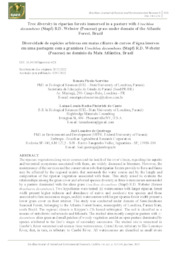Tree diversity in riparian forests immersed in a pasture with Urochloa decumbens (Stapf) R.D. Webster (Poaceae) grass under domain of the Atlantic Forest, Brazil.
Tree diversity in riparian forests immersed in a pasture with Urochloa decumbens (Stapf) R.D. Webster (Poaceae) grass under domain of the Atlantic Forest, Brazil.
Author(s): SCERVINO, R. P.; CANTO, L. L. R. P. do; QUEIROGA, J. L. de
Summary: Abstract: The riparian vegetation along water courses and the health of the river’s basin, regarding the aquatic and terrestrial ecosystems associated with them, are widely discussed in literature. However, the maintenance of the services and the conservation role that riparian forests provide to flora and fauna may be affected by the regional matrix that surrounds the water course and by the length and composition of the riparian vegetation associated with them. This study aimed to evaluate the relationships among the grass cover and arboreal species diversity in three watercourses surrounded by a pasture dominated with the alien grass Uroclhoa decumbens (Stapf) R.D. Webster (former Brachiaria decumbens). Two hypotheses were tested: (i) watercourses with larger riparian forest width present higher richness and abundance of native and zoochoric tree species and those associated to late succession stages, and (ii) watercourses with larger riparian forest width present a lower grass cover on their interior. The study was conducted under domain of Semideciduous Seasonal Forest, belonging to the Atlantic Forest biome, municipality of Londrina, Paraná State, south Brazil. The regional climate is Köppen’s Cfa humid subtropical. The soil is classified as a mosaic of eutroferric red nitosols and lithosols. The studied sites mostly comprise pasture with U. decumbens alien grass and small patches of woody vegetation amidst an open pasture dominated by species attributed to the first’s stages of secondary succession. The studied site is immersed in Cambé’s River watershed and contain three watercourses, Cristal River, tributary to São Lourenço River, that, in turn, is tributary to Cambé River. All watercourses are classified as small rivers (Brazilian Forestry Code, federal law: n. 12.651/2012), with length inferior to 10 m between both riversides. The riparian vegetation shares similar characteristics and structure, encompassing woody vegetation with pioneer trees species and high canopy openness. All riparian forests are immersed in pastures with U. decumbens grass. Transects of 200 meters long, measuring one meter wide from the line on both sides of the transect, and one square plot (25 m2) were allocated on the interior of each riparian forest. Transects were evaluated as arboreal species richness and the length of the riparian forest strip. In each plot, the arboreal vegetation was inventoried as species richness, abundance and density, and the U. decumbens cover was measured. The riparian forest width was arranged in two classes, forests with width ? 5 m or ? 10 m. The studied forests were compared as richness, abundance, density, and grass cover. The correlations among the riparian vegetation with the forest width and grass coverage (%) were evaluated. Species richness, abundance and density did not differ among the watercourses. However, species abundance and density presented positive correlations with the riparian forest width, indicating that the larger is the riparian vegetation, the higher is the species density. Grass cover presents a strong negative correlation with the riparian forest width, indicating that narrow strips of woody vegetation present higher grass cover. A high positive correlation was observed with riparian strip width and native trees, suggesting that native woody species establishment is limited by the riparian strip width and that those rustic trees species are more capable to colonize these environments. Also, the correlation found with species that present abiotic syndromes and pioneer species indicates that trees that can colonize open areas are more suitable to establish on narrow strips of vegetation amidst a pasture. The relationships observed with zoochoric trees suggests that the fauna that visits these forests are tolerant to open areas and visit these areas independently of their vegetation width. The larger riparian forests present lower grass cover and these can be related to shadow micro-sites that reduce the luminosity which can affect the permanence potential of the dominance of U. decumbens. In this way, the data suggests that few plants can establish in these pasture landscape, and those more rustic trees which are able to establish under open areas, high grass cover and canopy openness, and that re-sprout after a fire, became more dominant. For these watercourses, with narrow riparian vegetation strips surrounded by an U. decumbens pasture, the high grass cover can restrict and plant diversity, acting on the course and velocity of secondary succession in these areas.
Publication year: 2023
Types of publication: Journal article
Unit: Embrapa Environment
Observation
Some of Embrapa's publications are published as ePub files. To read them, use or download one of the following free software options to your computer or mobile device. Android: Google Play Books; IOS: iBooks; Windows and Linux: Calibre.
Access other publications
Access the Agricultural Research Database (BDPA) to consult Embrapa's full library collection and records.
Visit Embrapa Bookstore to purchase books and other publications sold by Embrapa.

